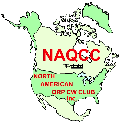
 | NAQCC News |
| Sep 17, 2011 | NAQCC Web Site | Issue #150 | |
|---|---|---|---|
|
In this issue: 1. September Sprint 2. August Challenge Results 3. General Club News 3a. Chapter News 4. CW Assistance Project 4a. NAQCC QRS Nets 5. CW Cartoon of the Month 6. Member Spotlight 7. News Items and Articles by Our Members |
| 1. SEPTEMBER SPRINT: Two very important items top this entry. Please do not skip over them. 1. Dave W3KM, the author of GenLog emailed the following: "Hi John, I enjoy reading the NAQCC newsletter each month and I think your GenLog tutorial is awesome. Thanks. I thought the newsletter would be a good place to tell NAQCC members and GenLog users to change their browser favorites. My software will only be available at: http://www.qsl.net/w3km/ Up till now, my software has been on both verizon.net and qsl.net. However, Verizon no longer allows web site maintainence via FTP. They say `for security reasons`. Verizon sent me an e-mail on August 29, saying that FTP will be shut down as of August 21. It was shut down on the 21st. Nice eh. I can`t even upload a re-direct page. Thanks es 73 for now. Dave, W3KM." Isn't it terrible how some ISP's treat their valued customers. I would have nothing to do with Verizon after hearing that, but that's beside the real point. Be sure to note the change Dave mentioned. If you have a link to GenLog on your web site, be sure to check to see if it is correct. 2. It's time to get back on track after slipping below 100 logs last month. In doing some research, I think it was partly my fault. As far as I can determine from KE9DR's soapbox and my email program, the email reminder the day of the sprint was not sent last month. Bert's comments about being weaned from the reminders may be true. As we all get older, we need reminded of things. I know I do here. So from now on, it will be at the top of my list of things to do to be sure to send the sprint reminder the day of the sprints. Let's all make up for my shortcomings by entering this month's sprint this coming Wednesday evening, September 21 at 8:30P EDT, 7:30P CDT, 6:30P MDT, 5:30P PDT which in all cases convert to Thursday from 0030Z to 0230Z. Then after the sprint, send in your logs and 'punish' me by making me have to process at least 125 logs and preferably more. I know you can do it. Even if you've never tried contesting, or are relatively new at it, our sprints are one of the best training grounds around. Because of the friendliness of our members and the big bonus for straight key operation, our sprints are NOT the frantic high-speed kind you hear from other clubs. Newcomers will feel comfortable with the lower speeds and slower pace of our sprints. If you do hear someone too fast for you, in most all cases they will slow down (QRS) if you ask. So come on and give it a try if you've never done any contesting or sprinting before. You might find you like it and become regular participants as many of our members have done before you. There are many certificates and a prize associated with our sprints which I won't list here to not be accused of being any more wordy than I've already been so far. With the popularity of our sprints it is becoming necessary to spread out our activity a bit more than the frequencies listed in the rules. That's perfectly OK, but don't stray overly far or you may not be found. Also avoid other scheduled activities when you do so - other contests/sprints, nets, code practice, etc. Remember to be sure to read and understand the full general sprint rules and any specific rules for this month's sprint here. 2. AUGUST CHALLENGE RESULTS: The chess challenge proved a popular one and not as hard as a couple of us thought it might be with all the duplicate letters involved especially in making the word PAWN 8 times. Of course the A W N weren't bad since those are some of the most used letters in the USA call sign prefixes. However P might have proved tricky, but it really didn't. Anyway we had 8 folks make all the words - W9UX, K3WWP, N8XMS, KB1PBA, K1IEE, W2JEK, KD8HES, NU7T. Three others made at least one of the words - VA2EPR, VE3FUJ (missed making all words by just one letter), PA7PYR. Full Challenge results can always be found here. 3. GENERAL CLUB NEWS: So be sure to change any links you have to GenLog in your favorites and especially any you may have on your personal web site. Thanks. N1A - N1DN KB1PBA N2A - KQ2RP NW2K N3A - K3WWP WY3H KC2EGL N3ES AF3Z WA3HIC N4A - K2UFT KI4EBD N4EWT KB4QQJ N5A - W5YDM K5JYD N6A - KA6TVX N7A - WD8KRV N8A - N8XMS N8IUP KD8HES N9A - AB9JT KA9NOO N0A - KC0PMH N0TU K0HJC KD0V WD0K WB0QQTThe guidelines are very simple. All you do is operate normally, but use the special event call instead of your own. Period. The operators in a call area co-ordinate their on-air times among themselves. Remember conditions should be the best they have been for any of our previous anniversary celebrations with the Sun finally coming alive this year. It should be a real bang-up celebration. Don't you want to be a part of it? Now Brian WB9TPA is doing his best to try to start up more activity on Activity Days. Won't you help him out and help the club to achieve the purpose of activity days? See Brian's item in the Member News section below for more info. 3a. CHAPTER NEWS: Here is where our club chapters present news about their chapter activities. We currently have four chapters - European, Minnesota, Texas, and Western Pennsylvania. We're looking forward to expanding that roster. Chapters are more or less self-governing local gatherings organized by members in a geographical area and subject to a list of guidelines under the auspices of the NAQCC. If you would be interested in starting a chapter in your area, let us know and we'll send a copy of the guidelines. NAQCC EUROPEAN CHAPTER:  Items in this section are from EU Chapter President Matt MW3YMY unless otherwise credited. Questions or comments should go to The EU Chapter web site is at http://naqcc-eu.org/ NAQCC MINNESOTA CHAPTER: 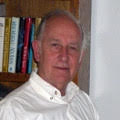 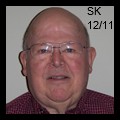 Items in this section are from Chapter President Rich WD0K (L) and/or Keith K0HJC (R) unless otherwise credited. Questions or comments should go to Greetings from the Minnesota Chapter! The summer season is over, and as our Chapter Prez, Rich, WD0K #664 says, Radio Season is upon us! Merlin, KD0V #2002, will be running Code Classes starting September 15th in Merlin's garage, using the same practice materials as last year. Merlin is working up a small 40-meter transmitter for the participants to build, running about 50 milliwatts. Merlin worked both K9OSC #3894 and K0HJC #3976 this afternoon with a 339 report on a slightly noisy band. The rig sounds nice! Bob, K9OSC, sent along a photo of an antenna tuner he built. 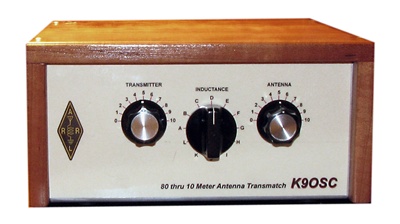 He says; "Regarding my antenna tuner, it basically a "T" match that includes a 4:1 balun for a long wire or balanced feeders. Rated at about 150 watts, it is a straight through type designed for field use. The chassis is a recycled aluminum panel and the cabinet is solid cherry wood. The front panel was crafted using computer drafting software and color printer. Clear postal tape covers the printed front plate making it water resistant. Thus far the tuner has handled anything I have hooked it up to it with ease. Rather than incorporating a SWR bridge in the unit, I use such metering circuits built into my transceiver. Parts were scrounged from hamfests and matched up to provide smooth tuning from 80 through 10 meters." Nice looking unit! Minnesota NAQCC'ers, we are still looking for input regarding interests and possible activities. If you have an activity that intrigues or interests you, please let us know. Please feel welcome to join us for Brunch and/or rag-chew, or send me an E-mail at k0hjc@arrl.net. Our Sideband rag-chew is at 1400 GMT on 3.707 Mhz, Monday through Friday. Our next Brunch is scheduled for September 23rd at 10:00 A.M.. at R. J. Riches Restaurant in Mounds View, Minnesota. Look for the NAQCC hat! NAQCC TEXAS CHAPTER:  Items in this section are from TX Chapter Director Ron K5DUZ unless otherwise credited. Questions or comments should go to The TX Chapter web site is at http://www.naqcctx.com/ The East Texas QRS Net (ETN) is meeting each Monday evening at 1900 CDST (2400 UTC) on 7121 KHz. Since the move to 40m, Allen, KA5TJS #4512 (NCS) has had check-ins from as far away as Alabama. The ETN net is open to all comers, not just stations in the Texas area, so if you hear the net in session please check-in. Watch for the next NAQCC Net e-mail for the latest information. Remember that all NAQCC members located in Texas are automatically members of the Texas Chapter. You can find the NAQCC Texas Chapter website at http://www.naqcctx.com/. NAQCC WESTERN PENNSYLVANIA CHAPTER:  Items in this section are from John K3WWP unless otherwise credited. Questions or comments should go to All chapter news can be found ONLY here in this section of the newsletter. We sent out picture QSLs of our August 18th WPA Chapter portable operation to each station we worked. If you worked us and did not receive a card, let us know at the email address above and we'll send another card to you. We received some QSLs in return with some nice comments on them we'd like to share with you. Art WB4MNK wrote, "Thank you for the QSO. Very nice QSL card with you, Mike, and Don. Looked like you guys were enjoying the portable op." We certainly were. Bob K9OSC wrote, "How very thoughtful to confirm our contact with NAQCC N3AQC portable operation in Kittanning Community Park. I wanted to be sure to work you fellows this time so I 'staked out' 14.060 where I watched, listened and waited. I heard you tuning up just before you first called CQ and there you were. The card is simply beautiful. Thanks so very much and I will add it to my collection of memorabilia from NAQCC." Yes, Bob answered my very first CQ on 20 meters about 15 minutes before our official starting time. Incidentally to give credit where it is due, Don K3RLL made up the picture QSL cards for the chapter. I was going to show what they looked like here, but decided against it. If you want to see what they look like, you'll have to work us on one of our outings. We plan to send one to each station we work at each operation, at least as long as we have funds in the NAQCC treasury to do so. The next scheduled outing will be October 10 when Mike and I will operate N3A from the Community Park, weather cooperating. We'll miss Don for this one as he'll be down in Florida till late next spring. Our first official activity of the WPA Chapter which was formed just after our portable operation was a visit by members Tom WY3H, Don K3RLL, and John K3WWP to the Skyview Hamfest near New Kensington PA. It was nice to meet some of our NAQCC members there and we even signed up one new member although we were just visiting and not intending to recruit members. It's nice to have the Skyview Club as a member of the NAQCC. Also several of the Skyview members are NAQCC members. I'm not going to mention them all here for fear of leaving someone out. But I would like to mention Bob WC3O whom we run into at every local hamfest we attend. Bob is an excellent chef as well as CW operator and he was busy most of the hamfest preparing breakfast and lunch for all the visitors. Oh and he took a break long enough to take one of the pictures we showed you in the last newsletter. Chapter members Tom WY3H, Tom's sons Ethan W3IRS and Ariel, and John K3WWP attended the 4th Annual BCARA Swapfest in Butler, PA on September 11, 2011. It was nice to see that moments of silence were observed during the swapfest. Some good bargains were had and I know Tom and I (K3WWP) picked up several items. I got a nice new keyboard for my computer for $1.00 to replace my old one which had some of the letters worn off the keys which doesn't bother a touch typer, but it also was in general suffering in other ways from old age and overuse. HI I also picked up a few other items including a bag of probably around 100 2-watt carbon resistors I plan to use in making some additional RF attenuators so I can operate in the mW range at other power values beside my current 930 mW. Also a couple DVDs by singer Daniel O'Donnell for my new DVD/VCR player I purchased a few days ago. I met Daniel years ago when I worked at WPIT helping engineer the Blarney Stone Irish program. This is a very well organized swapfest with really great bargains. I think you'll agree if you have attended or will attend next September. It was nice to meet some NAQCC members there including AA3LX and the omnipresent WC3O, to mention but a couple. 4. NAQCC CW ASSISTANCE PROJECT:  Items in this section are from CW Assistance Project Coordinator Ron K5DUZ (L) unless otherwise credited. If you are interested in helping out or need help with any CW and/or QRP matters contact: K5DUZ - Ron has become involved in another work project and will be unavailable to write info for this section for a while. If you would like to write something that you feel will be helpful to our members in learning CW or improving CW skills, please feel free to do so. Zeke KD8HES requested some info on a couple topics, so I'll (K3WWP) answer him here since it should be helpful to other members as well. Zeke asks, "What I'd like to know is how to call into a specific call area. If I wanted only 5's to answer me, what would the call be?" Simply add the area you are interested in to your CQs and end with a KN as in the following examples. CQ W5 CQ W5 CQ W5 DE KD8HES KD8HES KN That alerts anyone listening in the W5 call area (NM, TX, OK, AR, LA, MS) that you are trying to work someone in that area. The KN means ONLY stations in that area should answer you. CQ PA CQ PA CQ PA DE KD8HES KD8HES KN Now we're a little more specific wanting a QSO with Pennsylvania. CQ DX CQ DX CQ DX DE KD8HES KD8HES KN This time Zeke is looking only for contacts from outside his own country. I'm sure those examples give you all you need to know about 'directional' CQs. Remember if you hear such a CQ and are not in the target area, DO NOT answer unless it would be an extreme emergency situation of some sort. Zeke also asked about Zero Beating. This is one topic that should be mastered by every CW operator, but several factors make it difficult. First of all, each rig (especially the smaller dedicated QRP rigs) seems to have a different way of doing it. Let's cover the mainstream rigs first. I mean the big rigs designed for ordinary ham radio operation and used by QRPers by setting the power at 5 watts and enjoying the operating convenience these rigs offer. I do that with my Kenwoods - 480 and 570 - for example. Zero beating someone with this kind of rig is easy and in most cases that I know of is the same. You simply tune in the station until the tone of his signal sounds the same as what you hear from your sidetone keying monitor signal. Presto - you're zero beat. Well, unless you are tone deaf and can't distinguish one tone from another. Should you be tone deaf, there are gadgets that can match tones for you. One is described on my web site (http://k3wwp.com/) in my CW section. Some people also have the opposite of tone deafness - perfect pitch. They can probably zero beat someone down to a few Hz or better. If you have normal hearing, using the tone matching method in your ears/head should get you within maybe 25 Hz or better which for all practical purposes is close enough to zero beat. Remember to have your RIT, XIT, IF SHIFT in the OFF position while zero-beating or you will wind up NOT zero beat. Turning now to the smaller dedicated QRP rigs, there is no set way of zero beating that I know of that would cover all the If you use a small dedicated QRP rig and know exactly how to achieve zero beat with it, you're welcome to write up detailed instructions on how you do it and email them to us at 4a. NAQCC QRS NETS: 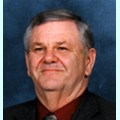 News and net reports in this section are from QRS Net Manager Dan AF4LB unless otherwise credited. Dan will handle all Net related material at this email address: Now our NAQCC QRS Nets schedule and activity report: NAQCC QRS Net
Sunday evenings local time which is Monday 0000Z on 7041 kHz.Date(UTC) NCS Participants 08-29-11 WC7S -10- WC7S W5IQS AC8AP N9RLO K4EMR N6GD W9UX WX5RM K3VIG K7LKU 9-5-11 AF4LB -7- AF4LB K3RLL N4OLN WM4X KE3HL WB4T K1IEE 9-12-11 AF4LB -10- AF4LB WX4RM W9UX AK9A N8IUP NV4T W4ISI WM4X K9EYT W4HH NAQCC ET QRS Net (East Texas)
Monday evenings local time, which is Tuesday 0000Z on 7121 kHz.Date(UTC) NCS Participants 08-30-11 KA5TJS -7- KA5TJS KE5YUM K4EAY K5OAI KE5YGA KG0YR W5IQS Thanks to Evan w5iqs for filling in for me last week. 73 Allen 9-13-11 ka5tjs -5- ka5tjs ke5yga w5iqs k4eay ke5yum NAQCC Rocky Mtn Regional/Continental QRS net (RMR)
Thursday afternoons 1400 MDST local time which is Thursday 2000Z on
14062.5 kHz.Date(UTC) NCS Participants 9-1-11 WC7S -4- WC7S WC4RM HB9DAX SM7ZDI 9-8-11 WC7S -2- WC7S WXRMR 9-15-11 WC7S -2- WC7S K9EYT NAQCC EC QRS Net (East Coast)
Thursday evenings local time which is Friday 0130Z on 7041 kHz.Date(UTC) NCS Participants 9-2-11 NO CHECKINS 9-9-11 AF4LB -4- AF4LB KF4IBU WX4RM KE3HL HAD TO CALL SHORT. SEVERE LIGHTNING STORM ARRIVED DURING NET. 9-16-11 AF4LB -3- AF4LB WX4RM W5IQS NAQCC PNW QRS Net (Pacific NorthWest)
Thursday evenings local time which is Friday 0200Z on 3574 kHz.Date(UTC) NCS Participants 9-2-11 KE7LKW -2- K7ALG KE7LKW 9-9-11 KE7LKW -4- K7ALG KE7LKW K7ZNP N6KIX 9-16-11 KE7LWK -3- K7ALG KE7LKW K7ZNPAll frequencies are +/- QRM. For more net info, see CW Assistance/QRS Nets on the web site. 5. CW CARTOON OF THE MONTH: 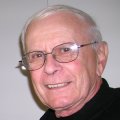 Let's take a comedy and/or nostalgia break now courtesy of Dick Sylvan W9CBT NAQCC #2062. Dick has been a long-time QRP/CW operator. One of his many talents is being a cartoon artist. Dick's cartoons appear monthly in the K9YA Telegraph, a free ham radio eZine, where he is staff cartoonist. The NAQCC is very honored to reprint Dick's cartoons originally published in the K9YA Telegraph. Dick has also authored a book entitled "Hi Hi - A Collection of Ham Radio Cartoons" available via his web site. A new cartoon has appeared in each of our even-numbered newsletters ever since their debut in Issue #058, November 17, 2007. 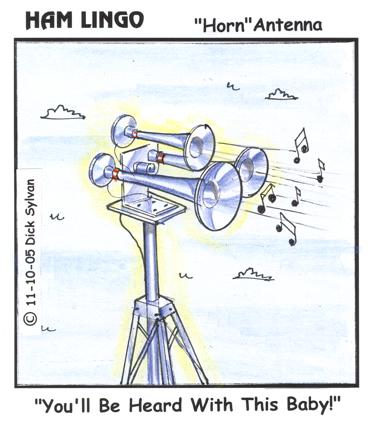 6. MEMBER SPOTLIGHT:  This section is managed by Paul N8XMS and any questions about it should go to Greg Trasuk VA3TSK #2695 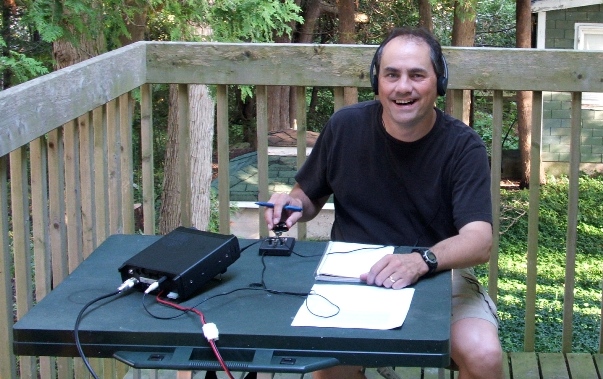 I'm rapidly approaching 45 years old. My wife Patti and I have two children, Cameron, who's 12 and Gillian, who's 10, and Black Labrador Retriever, Duncan who's almost 5. Professionally, I've been an Engineer, Manager (in the electronics manufacturing industry) and small businessman. The past few years I've been teaching software development techniques to corporate clients. I was interested in radio and electronics from an early age. Although I did a lot of reading about Ham Radio when I was younger, I never managed to learn code, so never got licensed. Around 2007, my son found some of my old radio books and started showing some interest, so I checked to see whether there was an age requirement for him to get his license. I was overjoyed to find that Canada had dropped the Morse requirement. With some work on regulations and HF propagation I passed my Basic-plus exam in March of 2007 (in Canada, passing the Basic exam with greater than 80% gives you HF privileges). I picked up a Kenwood TS520 on eBay, and put up a dipole in the back yard. SSB was frustrating because of my poor antenna (small lot, without many options). Much better success with PSK31, but I felt like I was cheating. Around the end of 2007 I decided to shut the Kenwood off until I learned Morse, which took until June 2008. Nowadays I use code almost exclusively. With my small-lot antenna (now a 52-foot sloping doublet that runs from the top corner of the roof down to the back fence, fed with homebrew ladder line back to a tuner in the shack), I find that code or PSK is a far more satisfying way to make contacts than phone. Going out to the park or schoolyard lets me set up a far better antenna than I can at home. I use either an ICOM 703 or SWL DSW-20 and a dipole between trees. It never ceases to amaze me what you can do with less power than a Christmas tree lamp. Probably my most memorable contact was my first DX contact, to England at 5W on 40M CW. Cool stuff. We have an active local club, the Burlington Amateur Radio Club, which I've been honored to serve over the last three years as VP, then President. Last year, we managed to have the highest Canadian Field Day score in the 1A-Battery category. This year, we gave in and used 100W, but still managed to run the entire event on batteries. The score wasn't quite as good, but we had a lot of fun. 7. NEWS ITEMS AND ARTICLES BY OUR MEMBERS: 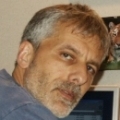 This section is a forum for you to tell other members what you've been up to on the ham bands or to submit an article dealing with some aspect of CW and QRP operation or equipment. Send your news items and articles to our news editor Paul KD2MX at On Monday, September 12th, 2011, I repeated the operation, but 12 meters was just loaded with noise. I did not hear many signals, and none that I called, acknowledged me. So I packed up and called it a day. I plan to continue to look for NAQCC members on every Activity Day that I can. Although being in Wisconsin, park operations will soon come to a close. BRRrrr! Schedule for the rest of September: 09/17/11, 18.080 MHz 09/23/11, 1.810 MHz 09/30/11, 10.116 MHz I plan to check the band for openings throughout the day, and this isn't intended to be a 24 hour marathon. Just a fun day of QRP contacts, I hope some one else from the club can join me. 73, Brian NOTE from K3WWP: See the Activity Days page here. Having both a four-element and five-element version of the Bruce Array made me more curious about the gain and patterns of these antennas. I could not find very much information about this aerial, even on the internet. In fact, some of the information on the internet was just plain false. Several sites pictured Sterba Curtains and 8JKs as Bruce Arrays. I also found some errors in my own previous studies of the antenna. So, I decided to do a bit more experimenting and learn more about the performance of these antennas. Fortunately, I work as a tech in the Electrical Engineering Dept. at Michigan State University. This allows me to utilize some very nice test equipment, as well as an anechoic chamber in which to make measurements on antennas. I again ran several of the same patterns as I did in last year's effort, in case I had made errors. I found I had made a few. I referenced some EZ-NEC patterns for the Bruce Array as printed in the 20th edition of the ARRL antenna book. Many of the antenna modeling programs are nice for getting an idea as to how an antenna might radiate, but they don't always show what an antenna might do here on earth with different feed methods. I built scaled down versions of the Bruce Array to test at 450 Mcs and 435 Mcs. One was fed in the center of the array. The other was fed at the end of the array. (This is how the full size versions were fed.) The aerials were constructed on poster board to hold their form for the tests. This way I would get "real world" pattern and gain figures, with several different variations. Then it was into the anechoic chamber for a spin! The results are interesting to say the least. 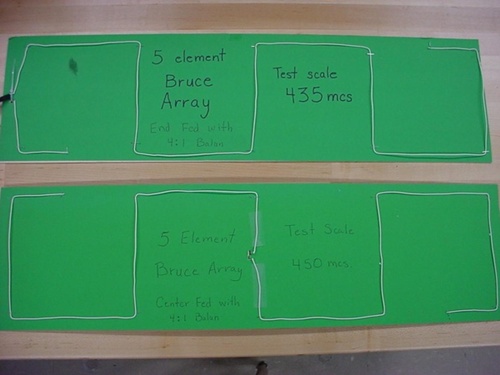 The two models of Bruce Arrays I hooked up to the network analyzer to see what the SWR and BANDWIDTH were. The plots on the network analyzer showed the antenna to be very broadbanded. It shows 2-to-1 SWR frequency across the bandwidth from 422 Mcs to well over 500 Mcs. 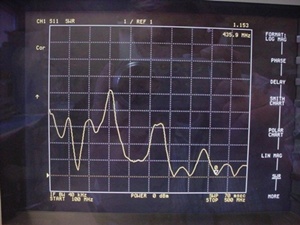 SWR and Bandwidth plot on NetAnyzr - SWR 1.153:1 at 435.9 Mcs This wide bandwidth was also evident during our on air tests during Field Day. The full size Bruce Array for 40m covered the entire 40m band with less than 1.3:1 SWR. In the CW segment, the REF PWR meter never moved. Very nice indeed. Then I wanted to know about the gain. Textbook figures indicated a gain of about 4.3 Dbd, and 5.3 Dbd for the four and five element arrays. I wanted to know if the real gain figures were close to this. So my first step was to measure a dipole for reference. This also insured the integrity of the chamber and the measurement equipment. Then I measured the arrays and compared the two figures to get the gain. I ran all of my pattern plots at least ten times each to get averages and to avoid errors. There were some instances where "feed line" orientation, as it came away from the antenna, caused one lobe to have slightly more gain. 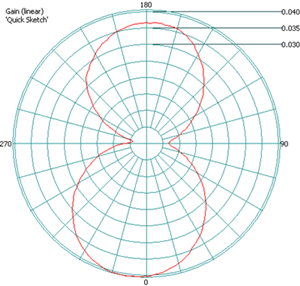 Dipole pattern at 435 Mcs. The dipole pattern shows a "textbook" figure eight. It doesn't get much better than this! This also confirmed that the anechoic chamber was operating as it should, as well as giving a baseline reference from which to measure gain. Then the Bruce Arrays each took their turn in the chamber. Below is the four element. Some lobe skewing is evident. This could be changed slightly depending on the orientation of the feedline coming away from the array. 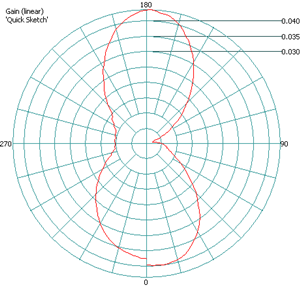 Actual Gain: 4.2 Db over a dipole. Next below is the five element version. As you can see, there are some side lobes forming here that are not present in the four element version. These side lobes were actually beneficial during Field Day for QSOs in those directions. 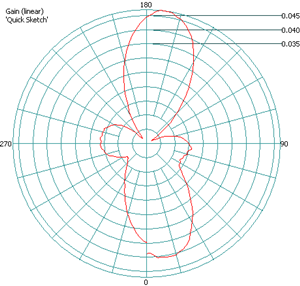 Actual Gain: 4.8 Db over a dipole. Then I wanted to see what the patterns looked like if we fed them on harmonics, as we also tried during Field Day. When fed at the harmonics, the antennas did well for radiators but gain suffered. 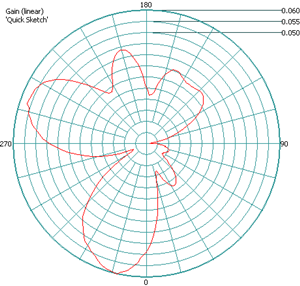 The above graphic shows what the four-element array looked like at two times the resonate frequency (as if we loaded up the 40m array on 20m). There is good coverage in several directions. 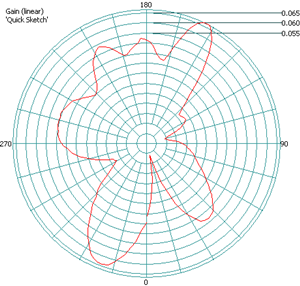 Above is what the five-element array pattern looked like at two times the resonate frequency (as if we loaded up the 20m array on 10m). There is good, wide azimuth coverage. 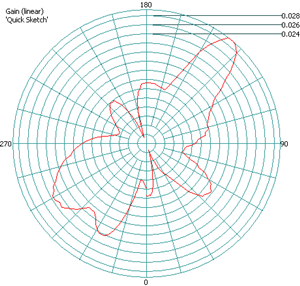 And above is what the five-element pattern looked like at three times the resonate frequency (as if we loaded up the 40m array on 15m). There is good coverage in several directions. Then I wanted to know what the patterns looked like if we fed the arrays at 1/2 the design frequency, as if we were to load up on 80m. Here is where I made an important observation. There was a difference between the "ends" folded in, or folded out. 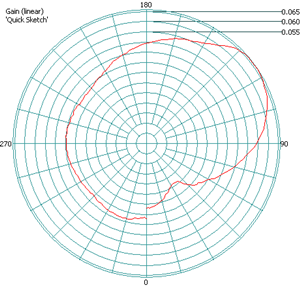 Above is the four-element Bruce Array at 217 Mcs with ends folded inward. There is just a big buldge, somewhat egg shaped. Perhaps it is omni-directional at best. Next note the difference when ends are bent out. 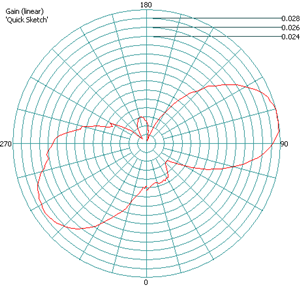 Above is the same Bruce Array at 217 Mcs with its ends folded outward. It looks as though it may have some possibility with an "endfire" pattern on 80 meters. Our real world Field Day tests with the "folded in" version showed that the antenna was very "narrow banded" on 80 meters. It had to be retuned every 20 Kcs of frequency shift. 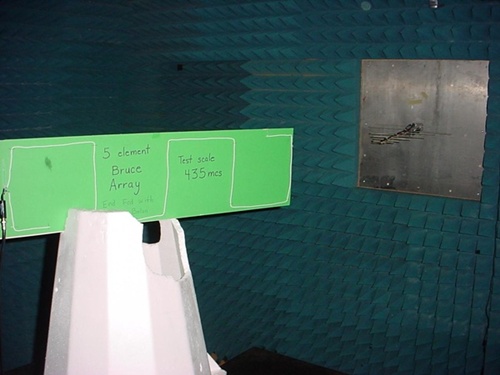 The Bruce Array model in the anechoic chamber. The real test for any antenna is using it during a contest like Field Day. The Bruce Array is a winner in that respect. The 20m curtain was raised to 85-feet on the high section. The 40m version was raised to 75-feet on its high section. In the initial tests right before contest time, I hooked up my FT-817 running 5 watts on 40m and worked a KP4 with 599 signal reports, right off the git-go. Then I tuned it up on 15m and got "instant joy" when I worked another Puerto Rican station on the 3rd harmonic, again with 599 reports. It was a real DX skyhook! Both the four-element and five-element arrays showed great received signal strengths. At the start of Field Day it was very clear that "WE" were the guys with the louder signal. We nearly always beat the other station when two or three were calling. Several runs on one frequency showed we had some "authority" to hold a frequency too. 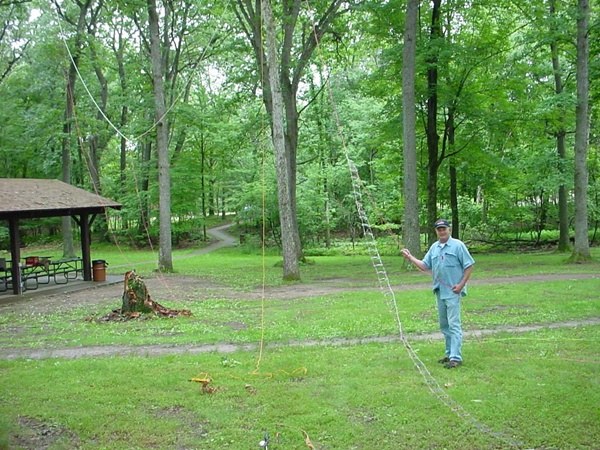 Hoisting up the 40m version with homebrew open-wire feedline. 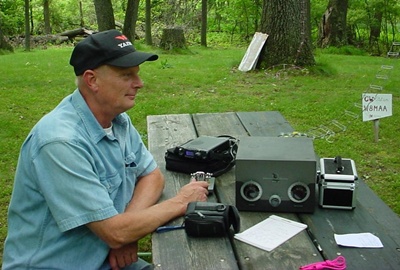 Here I am enjoying the "big curtain" at QRP power levels. Nothing like some good DX to make a QRPer smile! These aerials will certainly be a part of our future contest arsenal. The DX possibilities of these arrays may also make them attractive to some hams out there with tall supports and some acreage. Will they out perform a mono-bander at 70 feet? Probably not. But from a "most Bang for the Buck" perspective, it is a beauty. During Field Day, the Alaska, Hawaii, and Puerto Rico sections were "armchair copy". I hope this gives you some inspiration to try one of these Bruce Arrays out for yourself. I found them easy to construct, and very inexpensive. In true ham fashion, I scrounged all the wire for both the feedline and the antenna. The only thing I had to buy was a couple of strong ropes for the upper support, and some smaller nylon line as "former" supports. The 20-meter version was built with old RG-174U coax as the wire element. The 40-meter version used #18 gauge insulated stranded wire. Both were fed with "homebrew" open wire feedline. This was constructed of Plexiglas TM spreaders with #12 gauge stranded insulated wire. The Bruce Array is worth investigation if you want to build a wire antenna with considerable gain in two directions. The 40-meter version showed on the air that it was much superior to a dipole or full wave loop, particularly when most everyone else on 40m is using dipoles, extended Zepps, end feds, verticals, and loops. There did not seem to be much difference between four elements or five elements in the main patterns. However, the five element does have side lobes. This can be a good thing in a contest like Field Day, given our location in the middle of the continent. There was not much change in pattern from modifying the feed point. Center-fed seemed to "clean up" the patterns a bit. The biggest change to patterns were skew caused by how the feedline came away from the antenna itself. In real practice, one may not have much choice on the orientation of the feedline when it is strung up in the trees, and therefore some pattern bending would be inevitable. Also "ends" out instead of "ends" in, cleaned up the patterns on the harmonics nicely, but at the expense of another 1/4 wave in total length. One drawback is that the four and five element Bruce Arrays are LARGE aerials, requiring tall supports with at least 120-150 foot spans to hoist them to the sky. But compared to Sterba or Bob-tail curtains, the Bruce Array is only 1/4 wave tall, versus the others being 1/2 wave height. This can make the Bruce Array an option on 40 and 80 meters where tall trees can be used for supports. Our Field Day site in 2011 had many trees over 100 ft. This allowed us to get the aerials very high in the air, a big plus for any antenna. The other potential drawback is how to store them. 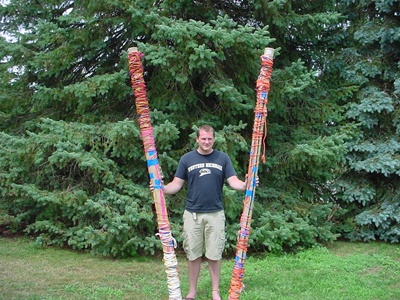 My son Jordon, KC8QYU, shows the rolled up Bruce Arrays Extra care needs to be taken when folding the array up. With all that wire and rope, it is a recipe for a tangled mess if not done properly. I found some cardboard shipping tubes six inches in diameter and eight feet long. With some help from a fellow ham, the big curtains can be "tamed" and simply wound up around the form, ready for storage until installation again in the next Field Day. I have a newfound respect for those who write antenna modeling programs. Although my gain figures did not "exactly match" the computer models, they were VERY close. These programs also gave me an approximate shape and gain figures to "shoot for" when constructing the models I used for testing. This made it easy to compare what I was seeing in my measurements with what I "expected" the pattern to look like. What's up for next year? Perhaps a three or four element Bruce Array for 80 meters. This antenna stuff is great! I wish to thank the following members of the Central Michigan Amateur Radio Club for guidance, help, advice, time, effort, and mentoring, all in the ongoing quest for a better FD antenna. My Mentors: Bill Chapman W8TJQ sk, Ben Hassle W8VPC sk Phil Perrault W8EKR sk Don Devendorf W8EGI sk. My Fellow CW Friends: Ron Harger WD8BCS, Bob Berger K8RDN (#2828), Scott Paul Rowe AB8VN, Ken Mcguire KC8LTL (#4036), Chris Raines KC8CAJ (#5411). Equipment used during on-air tests: Yaesu FT 817, Yaesu FT 990, Johnson "MatchBox", Homebrew "open wire" feedline. List of test equipment used in measurement and testing: HP 8508A vector volt-meter,HP 857B signal generator, HP 778D dual-directional coupler, HP 415E SWR meter, HP 437B power meter, Agilent 4396B Network/Spectrum/Impedance Analyzer. Special thanks to Michigan State University for the use of the test equipment, and the anechoic chamber. This research was inspired by articles written by Rudy Severns N6LF, and Michael Jesefsson SM8JAB, on the Bruce Array. 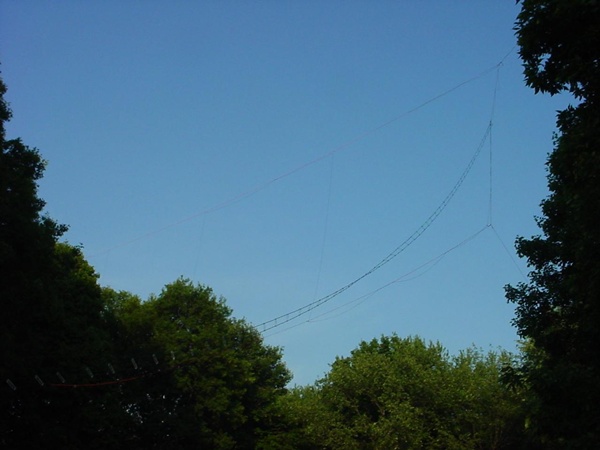 The Bruce Array (NOTE from K3WWP: The Bruce Array would be classified as a GAIN antenna for NAQCC sprints, awards, etc.) The third night there I got to talk to Jim, WB9VRP, in South Bend. We had a solid 20-minute QSO with my power at 1 watt. But my SWR was really high, 3:1+. Now I wished I had that tuner. Lesson One learned. The next day I adjusted the antenna so that the antenna was a perfectly vertical inverted vee, and voila! Apparently, messing around in the horizontal plane of the antenna scews up the impedance. Lesson Two learned. For the rest of our vacation it was very windy with sustained winds of about 35 mph on several days. So I moved the antenna indoors so that the feedline wouldn't tear the screen in the window. I didn't think that moving it indoors would make much difference, but I didn't get any more QSOs for the next week and a half. The sunspots were way down during that time so I wasn't sure if it was the antenna move, or the sunspots. It turns out it was both. After a quick email exchange with Dick W3DP #0742, I found out that indoor antennas do not perform as well as outdoor ones. Lesson Three learned. There wasn't much I could do about it. There were still a few nights of operating ahead of me, and with the sunspots coming back, I thought I'd have a chance of another QSO. Finally, on the last night of operating, at 11:15 pm, I talked to George, K9WWT, in Merrillville, IN. Lesson Four: You can get a QSO with one watt and a lousy indoor antenna snaked through doors, closets, around walls, over pictures, and still have fun doing it. While I have DSP, my Icom IC-718 has no CW filters, which makes moving away from QRM difficult at times. Oh, well! I use an old Speed-X straight key and it gets kind of dirty sounding (electronically). What could I do to fix that? Oh, I know...get a bug. But, I'd rather get a new straight key. The Begali Camelback looks beautiful. Pricey, but it's not like I buy new equipment every day. Here is a further demonstration on why CW QRP is fantastic. These are my last four QSOs: YU2VZ Serbia, F5DE France, KH6J Hawaii, (for my 1st Hawaii CW QRP...state #50 QRP) and KH6LC Hawaii. KH6J was worked on 40M while the other three were on 20M. I was running five watts into my off-center fed, folded dipole (180' x 90'). The antenna is only about 20 feet off the ground (at the most). We all keep saying it, CW QRP is the best! (NOTE: The dates are 10/1 0000Z through 10/2 2400Z. Be sure to publicize the NAQCC in any way you can if you enter this event - K3WWP) Come one come all, old timers and young guns alike. This is an EVENT to test or improve your cw skills and have a blast doing it. I will be operating from Pilot Mountain State Park USNC004 and yet to be activated Guilford Courthouse National Military Park during the 48 hour event. On behalf of Dick, K2RFP I suggest you: Get ready for some CW Fun! It is billed as an event and not a contest and is like no other CW activity that I know of, excepting of course, the last time Dick ran one like this! All amateur operators are welcome and encouraged to participate at the speed and level you wish. You can play by sending, receiving or BOTH!. The registration window is open at http://cwfun.org/. |
Club email address - The publication of our next newsletter will be announced via email to all members for whom we have a valid email address unless you specifically have unsubscribed from the email. Past on-line newsletters beginning with issue #042 are now archived on the site. So if you missed seeing any past issues, you can check them out in the archives. Unless otherwise credited, all items are written by K3WWP. If you came directly to this newsletter, we invite you now to browse the NAQCC Web Site. |